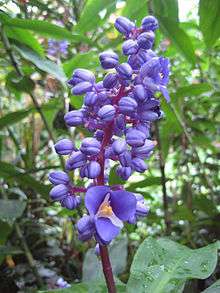Dichorisandra thyrsiflora
| Dichorisandra thyrsiflora | |
|---|---|
 | |
| Scientific classification | |
| Kingdom: | Plantae |
| (unranked): | Angiosperms |
| (unranked): | Monocots |
| (unranked): | Commelinids |
| Order: | Commelinales |
| Family: | Commelinaceae |
| Genus: | Dichorisandra |
| Species: | D. thyrsiflora |
| Binomial name | |
| Dichorisandra thyrsiflora J.C.Mikan | |
Dichorisandra thyrsiflora or blue ginger is a tropical plant which resembles ginger in growth and habit, but is actually related to the spiderworts (the genus Tradescantia). The plant is native to the tropical woodlands of North, Central and South America, specially in Atlantic Forest vegetation in Brazil. Of the family Commelinaceae, they are cultivated for their handsome spotted stems, large shiny foliage which is held horizontally, surmounted by striking blue flowers.
It was first described by the naturalist Johann Christian Mikan in 1823.[1]
It was first grown in England in 1822, and is recorded from Sir William MacArthur's catalogue in 1857 of plants he grew in Camden southwest of Sydney.[2] It has become naturalised in a small region of northeastern New South Wales in Australia.[3]
See also
References
- ↑ "Dichorisandra thyrsiflora". Australian Plant Name Index (APNI), IBIS database. Centre for Plant Biodiversity Research, Australian Government.
- ↑ Colin Mills (12 March 2009). "Dichorisandra thyrsiflora Mikan". Hortus Camdenensis. Retrieved 13 March 2011.
- ↑ Peter G. Wilson (1993). "Dichorisandra thyrsiflora J.G.Mikan". Plantnet - New South Wales Flora Online. Royal Botanic Gardens, Sydney. Retrieved 13 March 2011.
| Wikimedia Commons has media related to Dichorisandra thyrsiflora. |